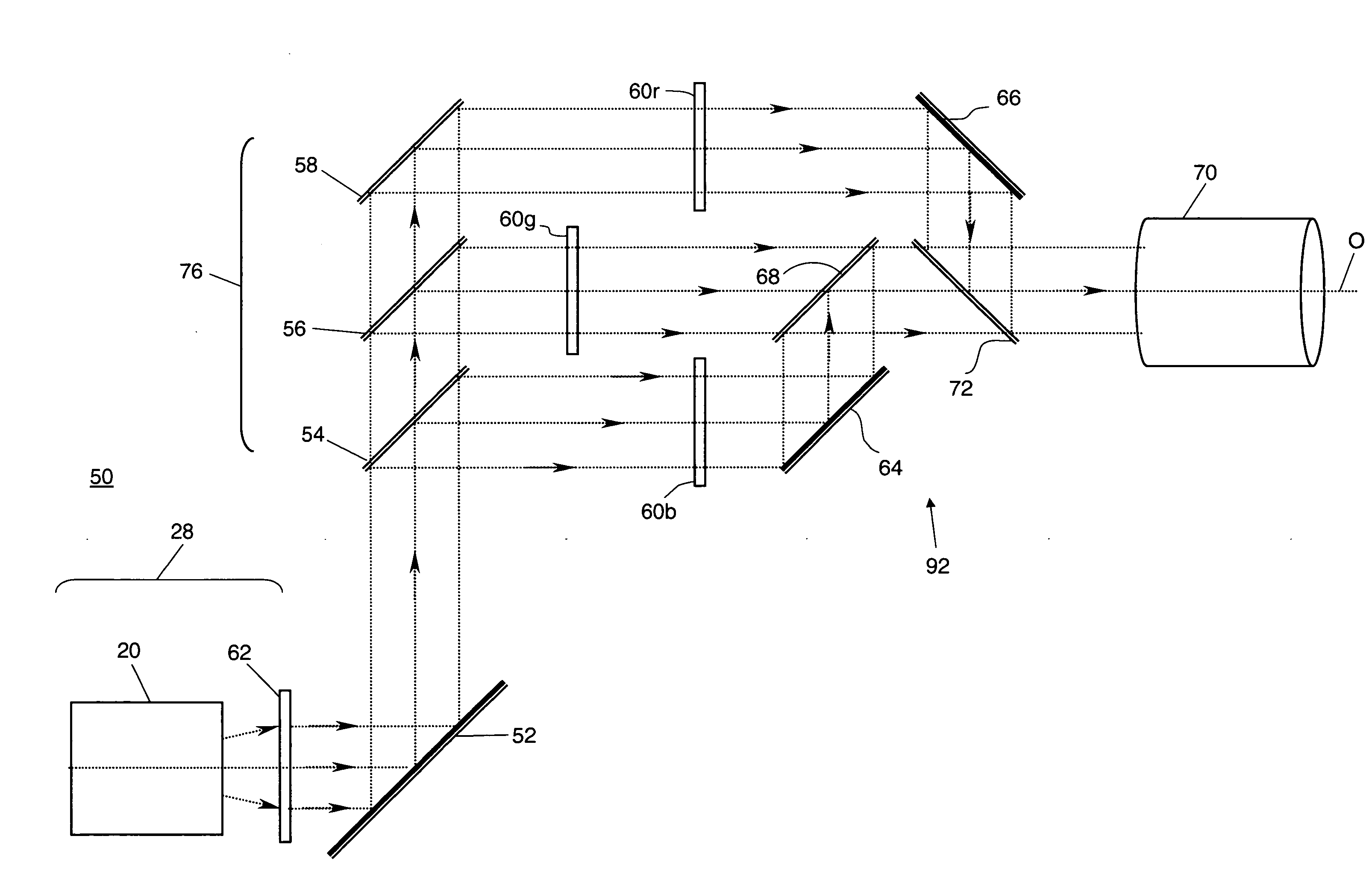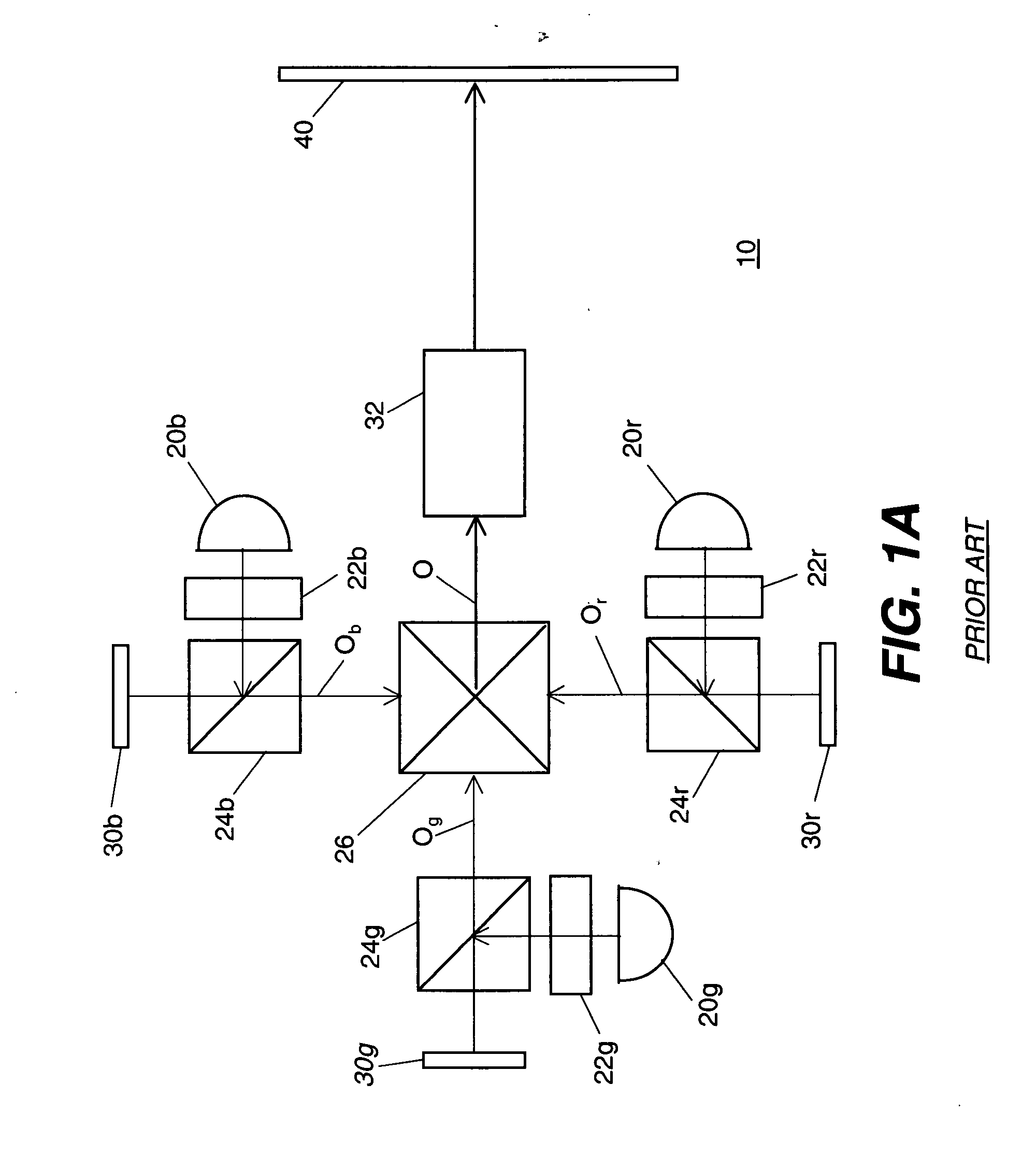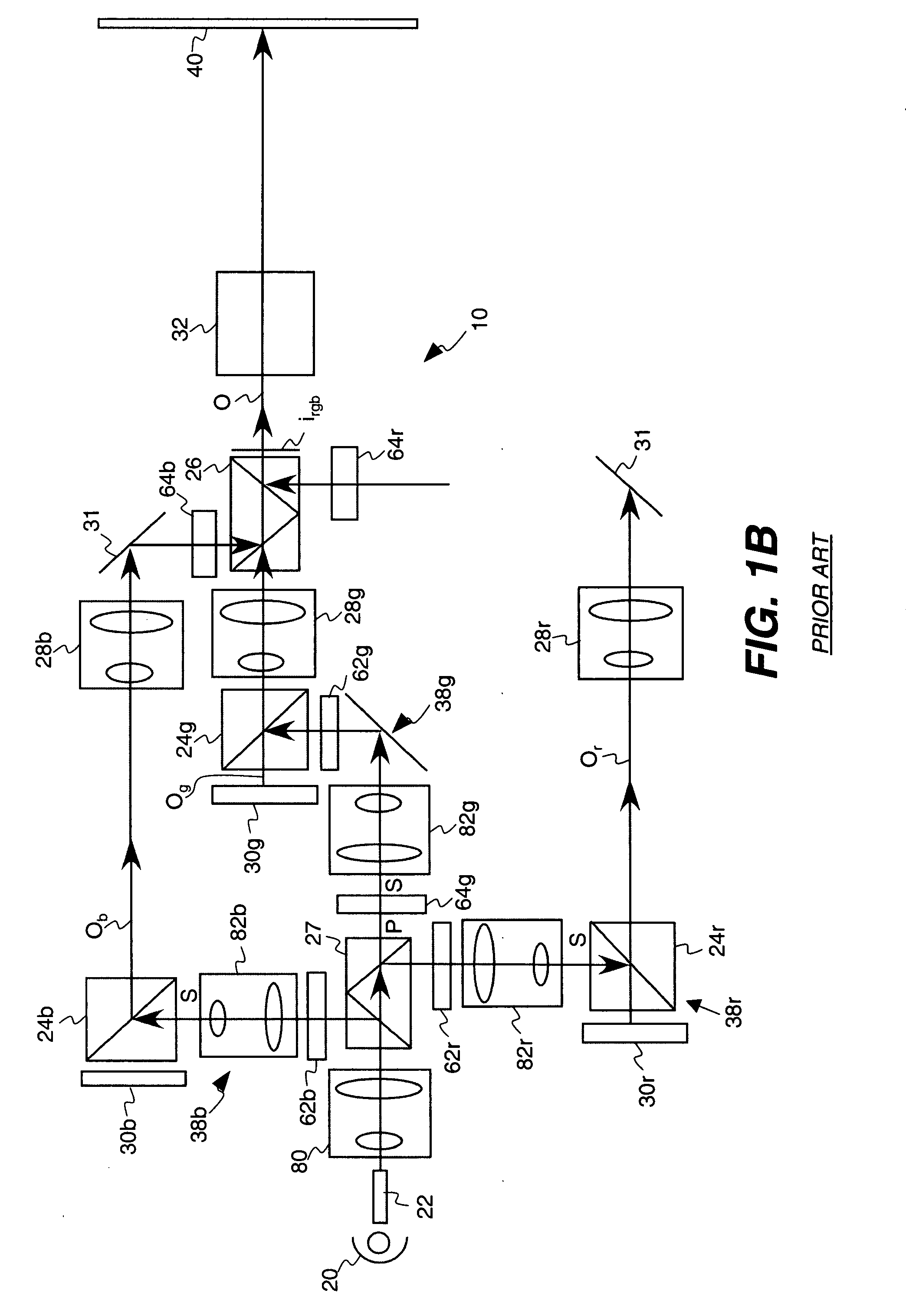Yet another factor that tends to bias
projector development efforts toward miniaturized devices relates to the dimensional characteristics of the film that is to be replaced.
One problem inherent with the use of miniaturized LCD and DMD spatial light modulators relates to brightness and efficiency.
Added complexity and cost result from the requirement to
handle illumination at larger angles.
Still other related problems with LCDs relate to the high angles of modulated light needed.
The mechanism for
image formation in LCD devices, and the inherent
birefringence of the LCD itself, limit the contrast and
color quality available from these devices when incident illumination is highly angular.
In addition to area and light angle considerations, a related consideration is that image-forming components also have limitations on
energy density.
That is, a level of brightness beyond a certain threshold level can damage the device itself.
Heat build-up must also be prevented, since this would cause non-uniformity of the image and color aberrations, and could shorten the lifespan of the light modulator and its support components.
For example, the behavior of absorptive polarization components used can be significantly compromised by heat build-up.
Again, this adds cost and complexity to an optical
system design.
However, considerations of etendue (or, similarly, Lagrange invariant) and
energy density, as described earlier, show that further
miniaturization will hamper the development of large-scale, theatre-quality projection apparatus using LCD devices, since it becomes increasingly more difficult to provide the needed brightness from smaller and smaller light-modulating devices.
Yet another difficulty relates to relative
defect size and fabrication yields.
As pixels become increasingly smaller, such as in the 8-20 micron range, a small defect of only 1 or 2 microns in size can have a substantial affect on display quality.
In general an aperture is provided for each pixel by a “black-matrix” pattern, in order to block incident light from negatively affecting the controlling
transistor, which can be photosensitive, resulting in contrast loss.
This aperture reduces the effective transmission of the device, resulting in an
aperture ratio of 60% or less for HTPS LC devices, compared with approximately 90% for LCOS.
However, with the small pixel sizes of a microdisplay (such as the HTPS device), an
aperture ratio this low is of a particular
disadvantage.
With respect to
image quality, this
aperture ratio may cause a visible “screen door” artifact when magnified to the display screen sizes required for typical theaters, that are around 40 feet wide or wider.
Additionally, in micro-displays at the scale of the HTPS array, the device active area is still relatively small, and heat dissipation of this light absorbing aperture from an intense
light source can further negatively affect the performance of the light modulator or the performance of its supporting optical components.
Therefore, while this
device type may be suitable for a digital projection application in a smaller venue, such as in a screening room or for business presentations, it does not appear to be capable enough for handling the amount of light required in typical cinema screen environments, where the average screen size generally requires a minimum of 10,000 lumens and where the largest of cinema display screens can require over 60,000 lumens.
This high demand is well above what LCD micro-display devices (that is, both HTPS and LCOS devices with less than 2 inch diagonals) are able to provide at their physical limits, without taking exceptional measures for heat compensation and other factors that raise the potential cost of the
projection system substantially.
One significant limitation of conventional design approaches using LCOS devices, then, relates to brightness.
Thus, the task of contracting or expanding the illumination and modulated light beams in each color channel adds cost and complexity to the optical design. FIG. 1B shows an earlier embodiment in which the incident light angle is steep at the LCOS device to increase collection efficiency, but reduced before and after to decrease the
spectral shift effects of the coatings, as well as the speed of the optical components.
When applying conventional optical design practices to the problem, the design of an electronic color projection apparatus that provides high light output has been shown to be particularly challenging, since each additional optical component in the
system tends to reduce light output and to introduce tradeoffs between
image quality and light output.
In order to meet the demands for higher brightness and improved
image quality projector output that would be competitive with film-based projection apparatus, however, it appears that considerable tradeoffs must be made.
In both of these cases, lamp output is insufficiently matched to the LC
spatial light modulator, with concomitant
impact on heat, cost, and lamp lifetime.
To withstand
high energy density levels needed to optimize brightness, more costly components must be used in illumination and modulated light paths.
For example, lower cost absorptive polarizers are supplanted by more costly
wire grid polarizers in many designs.
Thus, in an effort to obtain every available lumen at the output, conventional designs employ expensive, low reliability approaches that use either high-cost, high-performance optical components or multiples of lower cost, lower performance components.
However, the “direct-view” panels as currently fabricated for use in
flat panel applications, are not well suited for use in a high lumen
projector.
For example, the use of absorptive polarizers, which may be directly attached to TFT LCD panels, as these devices are commonly manufactured, is disadvantageous for image quality.
Heat created from light absorption in these polarizers, which typically exceed about 20% of the
light energy, causes consequent heating of the LCD materials, potentially resulting in a loss of contrast and contrast uniformity across the panel.
These absorptive color filter arrays would not be suitable for use in a high lumen projector, again because heat absorption could result in non-uniform image artifacts and damage to the device.
While high-resolution
monochrome panels have been made for the medical industry, these panels typically have
slow response times as they are often used for viewing still radiographic images.
However, in most cases, these apparatus have been proposed for specialized applications, and are not intended for use in high-end digital cinema applications.
While each of these examples employs a larger LC panel for image modulation, none of these designs is intended for motion picture projection at
high resolution.
Nor do the previous examples have sufficiently high brightness levels, or color comparable to that of conventional motion picture film, or acceptable contrast, or a high level of overall cinematic image quality.
As a result, none of these proposed solutions would be suitable candidates for competing with conventional motion picture projection apparatus.
This
system would not produce color efficiently, nor would it modulate the successive color frames quickly enough to prevent
motion artifacts.
In
spite of some considerable measures taken in the '849 Clifton solution, however, the efficiency of the resulting projector apparatus still remains relatively low.
Moreover, while contrast may be improved in the apparatus of the '849 Clifton et al. disclosure, the apparatus still falls short of the brightness requirements for digital cinema projection.
Significantly, the proposed solutions of the '849 Clifton et al. design fail to take
advantage of increased etendue when using a large LC panel size.
Some of the components of the proposed '849 Clifton et al. disclosure can adversely affect image quality.
For example, the use of an output
fresnel lens in front of the LC panel may be acceptable for the SXGA resolution levels of the apparatus described, but may cause significant contrast and image artifacts when utilized in a
projection system with a minimum of 2048×1080 pixels and 5000 lumens.
The use of lamps having arc gaps of up to 7 mm would not provide high efficiency, even where an LC panel of a 2-inch
diagonal is used.
The single panel color or
monochrome configuration described in the '849 Clifton et al. patent would not be efficient with color light, whether using common absorptive color filter arrays that would cause problems in a high lumen system, or using sequential color that would cause
motion artifacts.
Thus, it can be seen that, although some digital cinema projection apparatus solutions have been predicated on the use of LCOS LCDs for image forming, there are inherent limitations in brightness and efficiency when using the miniaturized LCOS LCD components for this purpose.
However, while projection apparatus using TFT LC panels have been disclosed, these have exhibited efficiency levels that are disappointing and have not been well suited to the demanding brightness levels combined with the additional requirements of
contrast ratio, color uniformity, color
gamut, and resolution as specified by the Society of Motion Picture and Television Engineers for certified digital cinema projectors.
Profits tend to be squeezed to the point where wattage of the projector lamp itself can be a significant cost factor that affects solvency.
Digital projection substantially changes this business model, but risks creating a somewhat more costly infrastructure for the theatrical venue.
Conventional microdisplay-based projectors, built using costly, high-performance components, can cost as much as three times the cost of film projection equipment.
Further, the
life expectancy of modern digital projection equipment is unknown.
Planned
obsolescence and component failure with conventional electronic projection apparatus raises profitability concerns.
 Login to View More
Login to View More  Login to View More
Login to View More 


